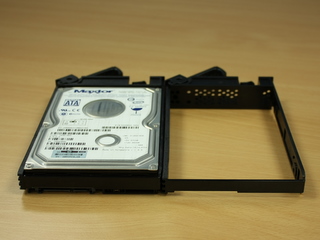Small ProLiant (Just Right Home Server)

The smallest Proliant.
On September 8, Hewlett-Packard announced the release of a new product - the smallest server in the large ProLiant family. The model does not have the traditional prefix DL / ML / ..., and is called simply HP ProLiant MicroServer.
The solution is positioned as the first server for small structures (up to 10 users), respectively, the price starts from $ 500.
The first shipments have just reached the distributors' warehouses, and one of the servers has already settled in my home.
Dry numbers:
- AMD Athlon II Neo N36L - Atom classmate with two cores of 1.3 GHz
- 1GB DDR3 RAM expandable up to 8GB (2 slots)
- 4 slots for 3.5 "hard drives with SATA interface
- 1Gbit Ethernet
- PCI-express x16 slot, PCI-express x1 slot
- slot for 5.25 "device with interface
- integrated SATA RAID 0/1
- 7 USB ports, incl. 1 internal and 4 on the front panel
- external eSATA port
- 150W power supply
- two cooling fans operating with a maximum noise level of ~ 24dB
Full details can be found in QuickSpec.
Before turning on the server was carefully examined, disassembled and studied. The impressions are extremely positive: the materials and the build quality are at a height. Perhaps the 100th series in some places looks and feels worse. It can be seen that the server is designed for installation in the front corner, and not in a dusty cabinet (nevertheless, in my home, the server was prepared for the far corner on the mezzanine). Smooth forms of matte plastic, neat illuminated logo. In addition to the aesthetic, the HP emblem also has a diagnostic function - the logo may blink in different colors and report error codes.


')
Behind the perforated door with a lock, there are 4 compartments for hard drives. One 160GB drive is included in the base configuration. The slide for the disks are bundled and any SATA disk can be screwed into them. For a small amount of money (without spending money on branded components), you can get 8 TB of RAW space, which is quite a lot for SOHO. The vendor’s concern for the user is especially touching - in the door you can find 16 spare cogs and the traditional for Proliant-s L-shaped key with hexagonal screws.


The motherboard is located on a small moving frame - convenient for installing memory / expansion cards. Cables, alas, have to be unfastened manually - not HotSwap. There is enough space on the board and in the case to install a good LowProfile video card, and / or an Ethernet / Wifi board.
The processor and chipset have extremely low heat generation and do not require active cooling. Thanks to this, the server was surprisingly quiet. The manufacturer has not deceived about the "beyond hearing" - in normal operation, only noisy screws are heard - the vibrations from them are transmitted to the case. The huge fan on the back wall works at low revs and is practically unheard of. Confused only a small cooler in the power supply.

Having collected everything back, I encountered the choice of OS: the manufacturer officially supports Windows Server 2008 and RHEL. This is of course True Enterprise, but not our choice. The processor supports AMD Virtualization Technology - you can try to run some kind of hypervisor. I found reviews on the Internet about running ESXi, but without support for onboard RAID.
This same RAID did not work out of the box under fresh Debian. It was terribly lazy to mess around, so I installed Ubuntu Server, where everything worked perfectly.
Now on the server is spinning:
- Transmission downloads and distributes torrents.
- FlexGet parsit RSS trackers and gives new items to Transmission
- Time Machine adds backups to server
- UPnP media server distributes music and video
- AFL file loader - native protocol for Macs. The data exchange rate is 2 times higher than that of Samba: AFP shows 90MB / s for read / write, against 45 for Samba.
At the same time, the load on the process / memory is minimal and there are enough free resources for additional services.
In the near future we plan to install a pair of 2TB screws, a video card with an HDMI output, connect the TV to the TV with a 20-meter HDMI cable and run XBMC.
Office application
Another of these glands took its place in our local office. It serves as a file player for 10 people. Practically all services in the company are centralized, and earlier for exchange of 10-megovy presentations among themselves it was necessary to use mail or, being the devil knows where, SharePoint Server.
We plan to install a DAT72 tape drive found in the bins - backup to an alienable medium!
There is no need to worry about the reliability of iron - as for the older brothers Proliant, for Microserver you can buy one of the packages of the advanced service. The most critical of them - 3Y 6h Call-to-Repair, implies that within the next 3 years, a maximum of 6 hours after your call to HP service, the server will already be running.
A small server is a big swim
I hope Microserver will be a great success both in home systems and in small offices. With a price that is comparable to different SOHO NAS, scalability and flexibility are incomparably greater.
UPD.
I received a lot of feedback about the fact that the motherboard does not hold PCIe devices with a consumption of more than 25W, and therefore no decent viewer can be supplied.The answer is: ATI HD 4350 has a TDP of 20W - this is the card I'm going to use
Source: https://habr.com/ru/post/109685/
All Articles